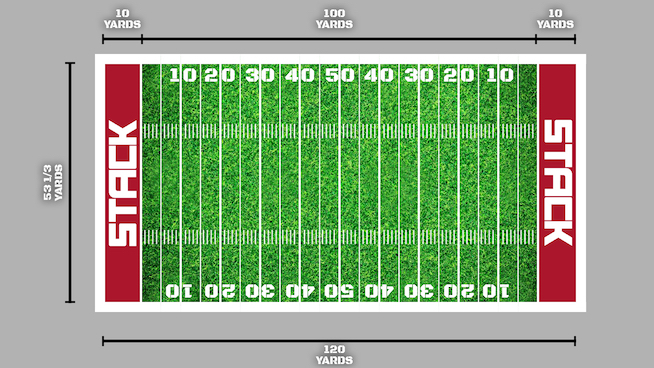NFL Combine 40-Yard Dash Champion John Ross’s Humongous Hamstrings Are Proof Strength Is The Key To Speed
People were expecting former Washington receiver John Ross to run a fast 40-Yard Dash at the NFL Combine. After all, his blazing speed helped him rack up 1,150 yards and 17 touchdowns during his final season at UW. But was he really speedy enough to break Chris Johnson’s absurd NFL Combine record of 4.24 seconds? It turned out he was—with a 100th of a second to spare. Ross’s 4.22 40-Yard Dash at the 2017 NFL Combine set a new bar for speed and sent his draft stock skyrocketing.
But how did the 5-foot-11, 188-pound Ross get so dang fast? A lot of his speed comes from his posterior chain. The posterior chain includes the muscles on the backside of the body, including the glutes and hamstrings—two essential muscles for producing speed. These muscles extend the hips and flex the knees, two movements critical to sprinting.
RELATED: The 10 Best Speed Exercises for Athletes
Though field work is an important part of developing speed, the foundation for getting faster is created in the weight room. More specifically, your strength in relation to your body weight can dictate how fast you’ll move on the field. Ryan Flaherty, CEO of Prolific Athletes (Carlsbad, California) and trainer to elite athletes like Marcus Mariota and Russell Wilson, told STACK he can usually estimate an athlete’s 40 time based just on the player’s strength-to-weight ratio. “I can determine with 99.7 percent accuracy what your 40-Yard Dash time is, based on your strength-to-weight ratio,” Flaherty said.
RELATED: Why Body Weight And Deadlift Max Closely Influence 40-Yard Dash Time
This is because speed and acceleration are all about ground force. When you sprint, you put force into the ground with your feet. That’s what propels you forward. The more force you can put into the ground with each stride, the faster you’ll propel yourself forward. How much force you can put into the ground ties directly into the strength and stability of your hamstrings and glutes. It should be no surprise, then, that Ross has absolutely humongous hamstrings. Just check out these shots we grabbed while filming Ross for our Path to The Pros series:
The man is built like a Centaur! Those massive hamstrings are the key to Ross’s record-setting speed, as they provide the horsepower to create incredible ground force.
READ MORE:
RECOMMENDED FOR YOU
NFL Combine 40-Yard Dash Champion John Ross’s Humongous Hamstrings Are Proof Strength Is The Key To Speed
People were expecting former Washington receiver John Ross to run a fast 40-Yard Dash at the NFL Combine. After all, his blazing speed helped him rack up 1,150 yards and 17 touchdowns during his final season at UW. But was he really speedy enough to break Chris Johnson’s absurd NFL Combine record of 4.24 seconds? It turned out he was—with a 100th of a second to spare. Ross’s 4.22 40-Yard Dash at the 2017 NFL Combine set a new bar for speed and sent his draft stock skyrocketing.
But how did the 5-foot-11, 188-pound Ross get so dang fast? A lot of his speed comes from his posterior chain. The posterior chain includes the muscles on the backside of the body, including the glutes and hamstrings—two essential muscles for producing speed. These muscles extend the hips and flex the knees, two movements critical to sprinting.
RELATED: The 10 Best Speed Exercises for Athletes
Though field work is an important part of developing speed, the foundation for getting faster is created in the weight room. More specifically, your strength in relation to your body weight can dictate how fast you’ll move on the field. Ryan Flaherty, CEO of Prolific Athletes (Carlsbad, California) and trainer to elite athletes like Marcus Mariota and Russell Wilson, told STACK he can usually estimate an athlete’s 40 time based just on the player’s strength-to-weight ratio. “I can determine with 99.7 percent accuracy what your 40-Yard Dash time is, based on your strength-to-weight ratio,” Flaherty said.
RELATED: Why Body Weight And Deadlift Max Closely Influence 40-Yard Dash Time
This is because speed and acceleration are all about ground force. When you sprint, you put force into the ground with your feet. That’s what propels you forward. The more force you can put into the ground with each stride, the faster you’ll propel yourself forward. How much force you can put into the ground ties directly into the strength and stability of your hamstrings and glutes. It should be no surprise, then, that Ross has absolutely humongous hamstrings. Just check out these shots we grabbed while filming Ross for our Path to The Pros series:
The man is built like a Centaur! Those massive hamstrings are the key to Ross’s record-setting speed, as they provide the horsepower to create incredible ground force.
READ MORE:












